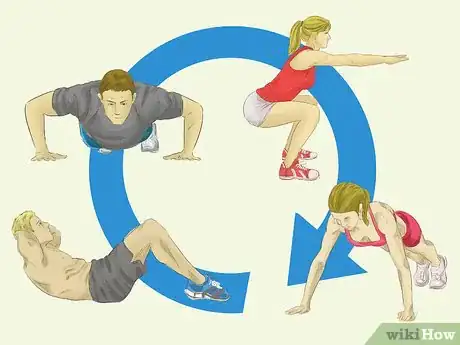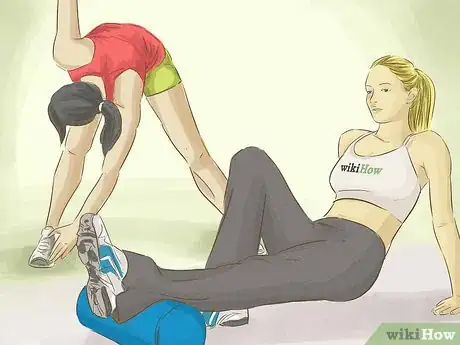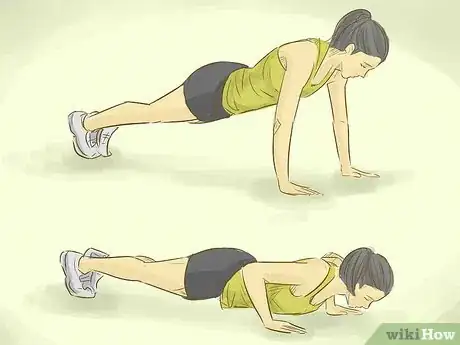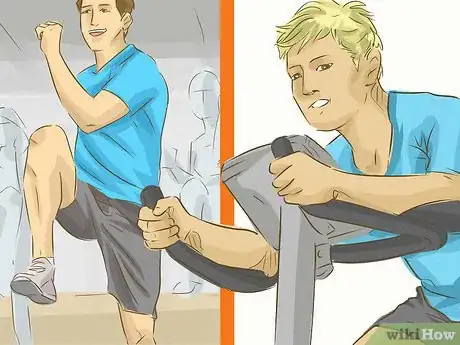This article was co-authored by Pete Cerqua. Pete Cerqua is a Certified Personal Trainer and Nutritionist. Pete is also a five-time best-selling author of books including "The 90-Second Fitness Solution" and "High Intensity Fitness Revolution for Women/Men" published by Simon and Schuster and Skyhorse Publishing. Pete has over 20 years of personal training and nutrition coaching experience and operates the 90-Second Fitness flagship studio in New York City.
This article has been viewed 254,323 times.
Ever been disappointed with results of a workout program? Military organizations around the globe have years of experience in workouts that give results. It's easy to see service men and women who are literally fighting fit and wonder how they manage to look like that. Most service men and women in the military don't have time for constant training, yet how do they stay fit? Read on for some general guidance and advice on fitness as used by some people in the military.
Steps
-
1Understand the basics of fitness. Fitness includes these four themes:
- Physical Training (will be referred to as PT throughout)
- Nutrition
- Cardiovascular Training (will be referred to as CT)
-
Rest.
- If any of these key themes are missing you will not make great gains. PT should be done at least three days a week and should include in this order a warm-up, dynamic stretching, workout itself, static stretching, and a cooldown. PT can be done with two different goals, muscular endurance or muscular strength. In this article PT will include only body-weight exercises. Nutrition is a self-explanatory theme, but will be described in detail later on. CT is similar to PT, but focuses on other forms of exercise to burn stored energy. Finally, resting is obvious. Get enough sleep and you will have met this goal.
-
2Learn that the Military and Special Forces units have used body-weight exercises for years now and get great results. Body-weight exercises that should be incorporated into your workout include:[1]
-
Upper Body (Arms, Chest, Shoulders)
- Pull-ups
- Super-mans
- Press-ups (push ups) in many variations
- Ball grips
- Chin-ups
-
Lower Body (Calves, Legs, Glutes)
- Calf Raises
- Squats in many variations
- Glute Marches
- Wall Sits
- Glute Bridge Raises
-
Core Muscles (Abdominals)
- Crunches
- Reverse Crunches
Advertisement -
Upper Body (Arms, Chest, Shoulders)
-
3Know that stretching allows for improved performance, reduced potential for injury, increased blood flow, and agility. Dynamic Stretches allow for full range and speed of movements overtime.[2]
-
4Dynamic stretches you should use prior to workout are:
- Neck Rolls, Up, Back, and Overs
- Hi Jack, Hi Jills
- Press-Press Flings
- Standing Toe 7ters
- Four-Way Leg Swings
- Trunk Rotations
- Four-Way Lunges
- Trunk Twisters
-
5Do these stretches for 2 seconds each is all that is required. Static Stretching develops flexibility.[3]
- Static stretches that should be used after workout as a cool-down include:
- Lateral and Forward Neck Stretches
- Swimmers Stretch
- Upper Back Stretches
- Posterior Shoulder Stretches
- Supine Back Stretch
- Overhead Trunk Side Stretch
- Torso Prone Stretch
- Hip Cross-Overs
- Iliopsoas stretch
- Butterflies
- Standing quadriceps stretches
- Sitting hamstrings
- Static stretches that should be used after workout as a cool-down include:
-
6Make sure you have a warm up. Either do jumping jacks, jump rope, or a stationary bike for five minutes.
-
7Train for endurance. Use repetitions of 13 and upwards. For strength, do 6-10 reps (12 might be pushing the boundary between strength and endurance). With strength comes muscle size, with endurance comes toning of the muscle.
-
8Think "Oh well, I can do 50 push ups! How can I possibly build strength with those?" Alternating push ups to make them harder so that you can only do 6-10 reps is easy. In fact, you can add resistance to any body weights exercises. Try doing the exercise more slowly, do exercises on side of the body (i.e. one arm push ups, one-legged squats), also, try wearing a backpack with small bags of sand, books, or anything that adds weight.[4]
-
9Proper nutrition is necessary to build and maintain a fit physique. To build muscle you must take in additional calories than needed.
- To determine how many calories you need a day, use this equation: 6.95 x Weight + 679 = Calories normally burned in a day.
- Now, take that amount and multiply by 1.7. So the final equation should be 6.95 x Weight + 679 = Daily amount x 1.7.[5]
- Now that you have figured out your daily expenditure, add 200-500 calories for muscle gain. For weight loss, subtract 200-500 calories from your daily expenditure.
-
10Eat whole grain foods, lean meats, fruits and vegetables, drink plenty of water. Only eat healthy fats such as those found in olive oils, fish, nuts, and flax seed oils. Saturated and trans fats will only shorten your life and add body fat. Aim to get 50% protein, 40% carbohydrates, and 10% fat in each meal to help you gain muscle.
- Chicken
- Fish
- Pasta
- Potato
-
11Remember that intense cardiovascular (aerobic) exercise which elevate the breathing and pulse to 80 -- 90% of your maximum should be done two or three times weekly, and never for more than 30 minutes. Do it only on your off training days. Stationary bikes are good, but sprints are even better.
Community Q&A
-
QuestionDoes doing body weight exercise on alternate days enhance muscle size?
 Community AnswerIt does. But only to a certain extent. If you want to gain more size, you need to do the exercises slowly and breathe deeply while doing them. And, of course, make sure you're eating a balanced diet.
Community AnswerIt does. But only to a certain extent. If you want to gain more size, you need to do the exercises slowly and breathe deeply while doing them. And, of course, make sure you're eating a balanced diet. -
QuestionI can strength train, but how do I do cardiovascular endurance exercises?
 Tom De BackerTop AnswererCardiovascular endurance exercise simply means running. Go running. Or swimming, rope skipping, boxing... You want to bring your heart rate up; not to the max, just higher than at rest, and keep it up for your entire workout. So go running, walk whenever you can't run anymore. Over the weeks, reduce the time and distance you walked until you can run the entire distance. E.g. if you're running 3k, but the first time you walk ten times, the next time, only give yourself 9 breaks, then perhaps only six, until none at all.
Tom De BackerTop AnswererCardiovascular endurance exercise simply means running. Go running. Or swimming, rope skipping, boxing... You want to bring your heart rate up; not to the max, just higher than at rest, and keep it up for your entire workout. So go running, walk whenever you can't run anymore. Over the weeks, reduce the time and distance you walked until you can run the entire distance. E.g. if you're running 3k, but the first time you walk ten times, the next time, only give yourself 9 breaks, then perhaps only six, until none at all. -
QuestionHow could I build lung strength when I have very weak lungs?
 Tom De BackerTop AnswererIf you have any lung condition, see your doctor to get that attended to. As for anything else, push yourself to the limit of what your lungs can handle, then stop exercising. Do that again, and again, and again. You will notice that it becomes easier to do it, which means you can push yourself to the next level. E.g. run a 1k race, 10 times, say twice a week. After five weeks, the tenth run will feel a lot easier than the first. So advance to a 2k race, etc.
Tom De BackerTop AnswererIf you have any lung condition, see your doctor to get that attended to. As for anything else, push yourself to the limit of what your lungs can handle, then stop exercising. Do that again, and again, and again. You will notice that it becomes easier to do it, which means you can push yourself to the next level. E.g. run a 1k race, 10 times, say twice a week. After five weeks, the tenth run will feel a lot easier than the first. So advance to a 2k race, etc.
Warnings
- Consult a doctor before doing high-intensity military exercises if you have a health problem.⧼thumbs_response⧽
References
- ↑ https://tonygentilcore.com/2018/11/army-ranger-taught-getting-strong-using-bodyweight-exercises/
- ↑ https://www.military.com/military-fitness/general-fitness/how-to-warm-up-prior-to-exercise
- ↑ https://www.military.com/military-fitness/general-fitness/how-to-warm-up-prior-to-exercise
- ↑ https://tonygentilcore.com/2018/11/army-ranger-taught-getting-strong-using-bodyweight-exercises/
- ↑ https://bmi-calories.com/calorie-intake-calculator.html
- "The U.S. NAVY SEAL Guide to Fitness and Nutrition" partially.
















-Step-24.webp)
















































